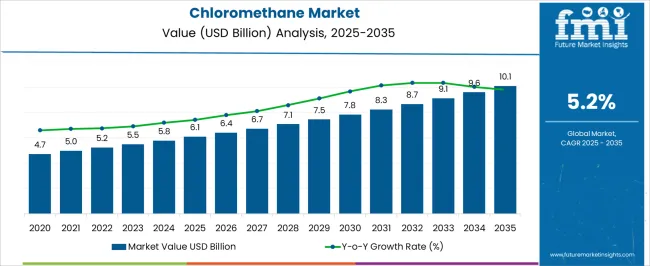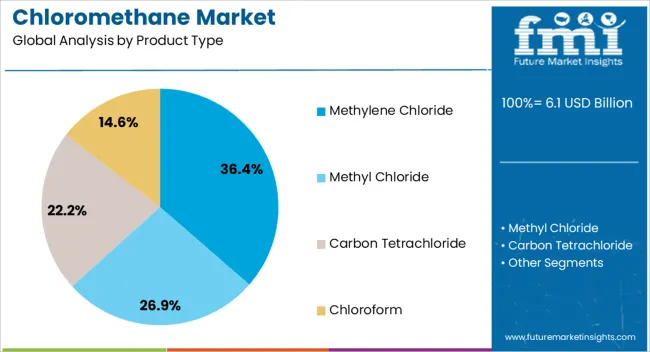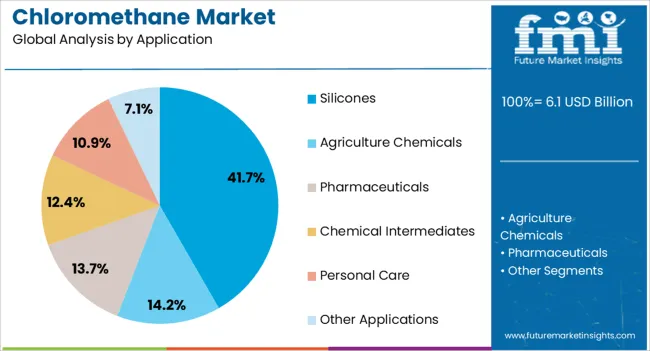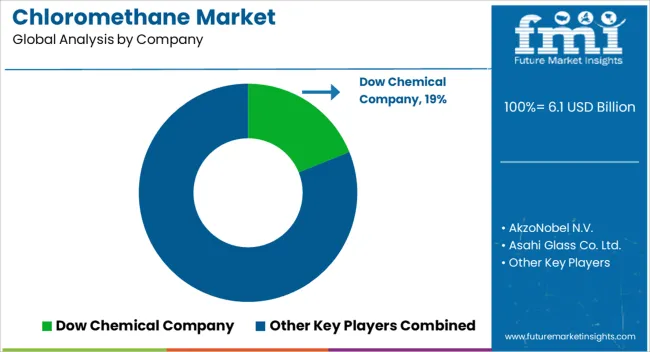The chloromethane market is experiencing stable growth driven by expanding industrial applications, rising demand from chemical processing industries, and increasing use in pharmaceuticals and silicone production. Market performance is being supported by technological advancements in production methods that enhance efficiency and reduce environmental impact. The current scenario reflects steady consumption across emerging economies due to industrialization and urbanization trends.
Regulatory measures emphasizing sustainability and controlled usage are influencing production standards and product innovation. The future outlook remains positive as downstream sectors such as pharmaceuticals, construction, and automotive continue to expand, thereby increasing demand for chloromethane derivatives.
Growth rationale is anchored on its versatility as a chemical intermediate, its critical role in polymer and pharmaceutical synthesis, and the ongoing shift toward cleaner, safer manufacturing practices Continuous improvements in plant capacity and strategic partnerships among key producers are expected to strengthen global supply networks and maintain a balanced market structure.

| Metric | Value |
|---|---|
| Chloromethane Market Estimated Value in (2025 E) | USD 6.1 billion |
| Chloromethane Market Forecast Value in (2035 F) | USD 10.1 billion |
| Forecast CAGR (2025 to 2035) | 5.2% |
The market is segmented by Product Type and Application and region. By Product Type, the market is divided into Methylene Chloride, Methyl Chloride, Carbon Tetrachloride, and Chloroform. In terms of Application, the market is classified into Pharmaceuticals, Silicones, Agriculture Chemicals, Chemical Intermediates, Personal Care, and Other Applications. Regionally, the market is classified into North America, Latin America, Western Europe, Eastern Europe, Balkan & Baltic Countries, Russia & Belarus, Central Asia, East Asia, South Asia & Pacific, and the Middle East & Africa.

The methylene chloride segment, holding 36.4% of the product type category, has been leading the market due to its extensive utilization as a solvent in paint removers, adhesives, and pharmaceutical manufacturing. Its dominance is being maintained by its efficiency in extraction and formulation processes where high solvency and controlled volatility are required.
The segment’s growth has been reinforced by consistent demand from end-use industries and the availability of advanced production technologies that ensure purity and process stability. Regulatory compliance measures and safety handling improvements have mitigated environmental and occupational risks, supporting sustained industrial use.
Market participants are investing in optimized recovery and recycling systems to reduce waste and enhance sustainability These collective factors are expected to preserve the segment’s leadership while enabling stable long-term growth within the chloromethane market.

The pharmaceuticals segment, representing 13.7% of the application category, has emerged as a key growth area owing to the extensive use of chloromethane derivatives as intermediates in drug formulation and synthesis. Demand has been supported by the rising global production of active pharmaceutical ingredients and the growing preference for high-purity solvents in manufacturing processes.
Stringent regulatory standards for quality and safety have driven the adoption of refined chloromethane compounds that meet pharmaceutical-grade specifications. The segment’s stability is further reinforced by increased investments in research and development aimed at enhancing synthesis efficiency and environmental compliance.
Expansion of pharmaceutical manufacturing facilities in emerging economies is expected to sustain demand growth, while continuous advancements in solvent recovery systems are set to improve cost efficiency and ensure consistent market expansion over the forecast period.
Trade Policies and Regulations Affecting Chloromethane Availability
The global market is forecast to rise owing to high demand as a chemical intermediate. Around 85% of the gas in the world is consumed in the United States, China, Japan, and Western Europe. Surging demand for silicone elastomers across various end-use industries is anticipated to drive growth.
Chloromethane availability is impacted by international and regional policies and regulations. Hence, the global sector is anticipated to rise at a moderate pace. For instance, international agreements like the Montreal Protocol phasing out chloromethane use in certain applications in developed countries are anticipated to hamper demand.
Similar protocols are limiting use for an eventual phase-out, thereby significantly restricting trade. Regulations of trade blocs like the European Union (EU) and North American Free Trade Agreement (NAFTA) regarding toxic chemical trade between member countries are stricter than the Montreal Protocol requirements.
Beyond the Montreal and Kyoto Protocol, individual countries can implement stringent import and export controls. Government policies promoting the development and adoption of safer alternatives to chloromethane are anticipated to augment demand. However, country-specific trade restrictions can negatively affect the availability of the gas globally.
Restricted supply can lead to a potential surge in prices and shortages in certain regions. Strict regulations can result in the emergence of black markets, especially in countries that have limited access to legitimate channels. The only solution to this problem will be to innovate alternatives that are not just efficient but also cost-effective.
Growth in Developing Economies Push Demand in Certain Applications
As developing economies undergo expansion, the demand for silicone, which is extensively used in construction materials, electronics, and other sectors, increases. As stated earlier, chloromethane is a raw material for silicone production.
The applications of colorless gas are rapidly expanding in developing countries. These include the usage in the pharmaceutical, adhesives and sealants, refrigeration, and silicone production sectors. Niche applications such as fumigation also rely on the gas.
China is expected to showcase a CAGR of 5.9% during the forecast period from 2025 to 2035. Growth is mainly driven by urbanization, industrialization, and increasing demand from end-user sectors.
Global sales between 2020 and 2025 remained stagnant at a CAGR of 3.1%. Total market size at the end of 2025 reached USD 5538.5 million. This slow-moving progress can be attributed to the phase-out of production and consumption in developed countries mandated by the Montreal Protocol.
Several developing countries have introduced stringent environmental regulations, potentially dampening demand. The shift towards safe and more environmentally friendly alternatives also contributed to declining sales.
There were regional variations wherein developed economies experienced a significant decrease in sales due to strict regulations and a wide range of available alternatives.
Developing countries, however, are experiencing growth in the market owing to ongoing applications in certain sectors and potential lag in adopting alternatives. Sales are projected to rise at a CAGR of 5.2% from 2025 to 2035.
Growth is attributed to the rising demand from specific applications that have limited or no widely available alternatives. The need for refrigerated transport and storage of fresh food products, government support for cold chain infrastructure, and rising demand for perishable foods are also driving the sector.
The global industry is influenced by evolving regional dynamics. This leads to variations in the growth scenario. As the industry progresses, the competitive landscape is anticipated to witness increased investments in technology advancements, mergers and acquisitions, and partnerships. These strategic initiatives aim to strengthen the global presence and cater to evolving industrial needs.
The section below depicts the chloromethane market forecast across the leading countries. The section also evaluates the prominent risks in specific countries. India is projected to emerge dominant, with a predicted CAGR of 7.8% through the assessment period.
China will likely follow with an estimated CAGR of 5.9% through 2035. Spain is projected to arise as the emerging sector in Europe, with a CAGR of 3.9% between 2025 and 2035. Developed nations like the United States, United Kingdom, Japan, and South Korea have low estimated CAGRs. This is owing to strict regulations on the use of methyl chloride to prevent the environmental impact.
The regional analysis will help businesses determine the key focus points. Information regarding the opportunities, growth drivers, potential risks, present and future trends, and detailed insights are provided in the full report.
Use of chloromethane as a solvent in pharmaceutical manufacturing is another key reason for growth across the globe. Ongoing research and development activities are expected to offer lucrative opportunities for growth.
Leading players are focusing on integrating advanced technologies to reduce the environmental impact of the toxic gas. These companies are consequently maintaining competitive prices. This is expected to help producers attract a large customer base while maintaining proximity to the profit margins.
| Countries | CAGR 2025 to 2035 |
|---|---|
| Italy | 3.4% |
| Spain | 3.9% |
| France | 3.7% |
| China | 5.9% |
| India | 7.8% |
India’s chloromethane market is projected to experience a CAGR of 7.8% during the assessment period.
The country’s growing electronics, construction, and personal care product industries are driving demand for silicones, which is pushing growth. While regulations restrict the use of the gas in refrigerants and fumigants, there are niche applications in pharmaceutical and chemical industries that require chloromethane.
India is aiming to reduce reliance on imported gas by increasing domestic production capacity. Domestic production is more cost-effective compared to imports, thereby augmenting demand.
China is projected to advance at a CAGR of 5.9% during the forecast period. The country has a booming shale gas industry that can serve as a feedstock for chloromethane production. This readily available and cost-competitive feedstock has spurred an increase in domestic production.
The desire for self-sufficiency and need to cater to the growing domestic demand in niche-specific sectors are projected to boost sales in China. This includes the country’s booming manufacturing sector, particularly electronics and construction materials.
Sales of chloromethane in Spain are projected to soar at a CAGR of 3.9% during the evaluation period. Implementation of stringent regulations in several developed countries has resulted in companies that shift the entire hubs to Spain due to less stringency.
In this scenario, the country saw a slight increase in chloromethane use for specific applications that are difficult to replace with alternatives in the short term.
This is, however, just a temporary strategy. The adoption of alternatives to chloromethane is slower in Spain compared to other developed countries. This is anticipated to lead to an increasing demand for the gas until the alternatives become more established.
The section provides an overview of the dominant segments of the market and anticipates the growth rates. This detailed segmentation will help companies identify the prime growing sectors and, hence, look for chloromethane investment opportunities accordingly.
Based on product type, the methyl chloride segment is projected to dominate the industry, accounting for an estimated share of 41.3% in 2025. By application, silicones will emerge as the assertive category, with a projected value share of 34.9% through 2025.
| Segment | Methyl Chloride (Product Type) |
|---|---|
| Value Share (2025) | 41.3% |
Methyl chloride is emerging as the primary product type in the sector. This growth is attributed to high versatility, which enables the product to be used in various chemicals across a wide range of sectors. While use is restricted in several developed nations, certain countries allow for utilization under specific applications where the availability of alternatives may be scarce.
The target segment is estimated to account for a value share of 41.3% in 2025. This advancement is ascribed to efficient and well-established production processes. As methylene chloride is being phased out due to health concerns, methyl chloride gets a chance to expand applications across industries.
The long-term dominance of methyl chloride is uncertain due to rising environmental concerns and evolving regulations. However, historical data proves the segment’s dominance in the years to come.
| Segment | Silicones (Application) |
|---|---|
| Value Share (2025) | 34.9% |
Based on applications, silicone is predicted to generate a share of 34.9% in 2025. Silicone is widely used in various industries due to unique properties. Its versatility drives demand, which, in turn, leads to an increased need for methyl chloride.
Silicone has various applications in electronics, personal care products, construction, and medical devices. Growth in these sectors is anticipated to propel demand for silicone. Use of chloromethane in silicone production for construction and automotive industries is also gaining impetus. The chemical is primarily used in structural glazing and weatherproofing, thereby contributing to energy efficiency of buildings.
Manufacturers prefer silicone owing to distinctive properties like electrical insulation, heat resistance, and chemical stability. Several companies have established innovative manufacturing processes that provide potentially cost-competitive options for producers.
In selected production processes, methyl chloride offers specific advantages depending on the desired properties of the final silicone product. Rising environmental concerns coupled with methyl chloride’s greenhouse gas emissions can limit the use of silicone production in the future.
The silicone industry is consistently evolving. Alternative raw materials and production processes that might not completely rely on methyl chloride are being developed. Innovations in the sector are anticipated to strengthen the future of the silicone segment.

Key players in the industry include Akzo Novel N.V., Asahi Glass Co. Ltd., Dow Chemical Company, Gujrat Alkalies and Chemicals Ltd., INEOS Group, and others. The industry faces intense competition from various fronts. These include alternative refrigerants, regulations, and product substitution.
Established players compete for a high share while maintaining production capacity. Constant change in regulations and intense competition from alternatives require companies to focus on cost efficient production processes.
Technological advances are set to substantially benefit producers. Among these innovations, the development of new methods to capture or destroy chloromethane emissions stands out as promising as this would enable continued use in certain applications.
One of the chloromethane market trends is the increasing focus on recycling and reuse, which can help reduce reliance on virgin gas production. The sector is constantly evolving and key players need to keep track of regulatory changes as well as technological advancements. Development of alternative solutions would also help leading players to strengthen position.
Industry Updates
Based on product type, the sector is segmented into methyl chloride, methylene chloride, carbon tetrachloride, and chloroform.
The product has several applications, including silicones, agriculture chemicals, pharmaceuticals, chemical intermediates, personal care, and other applications.
Based on region, the market is spread across North America, Latin America, Western Europe, South Asia, East Asia, Eastern Europe, the Middle East and Africa.
The global chloromethane market is estimated to be valued at USD 6.1 billion in 2025.
The market size for the chloromethane market is projected to reach USD 10.1 billion by 2035.
The chloromethane market is expected to grow at a 5.2% CAGR between 2025 and 2035.
The key product types in chloromethane market are methylene chloride, methyl chloride, carbon tetrachloride and chloroform.
In terms of application, pharmaceuticals segment to command 28.6% share in the chloromethane market in 2025.






Our Research Products

The "Full Research Suite" delivers actionable market intel, deep dives on markets or technologies, so clients act faster, cut risk, and unlock growth.

The Leaderboard benchmarks and ranks top vendors, classifying them as Established Leaders, Leading Challengers, or Disruptors & Challengers.

Locates where complements amplify value and substitutes erode it, forecasting net impact by horizon

We deliver granular, decision-grade intel: market sizing, 5-year forecasts, pricing, adoption, usage, revenue, and operational KPIs—plus competitor tracking, regulation, and value chains—across 60 countries broadly.

Spot the shifts before they hit your P&L. We track inflection points, adoption curves, pricing moves, and ecosystem plays to show where demand is heading, why it is changing, and what to do next across high-growth markets and disruptive tech

Real-time reads of user behavior. We track shifting priorities, perceptions of today’s and next-gen services, and provider experience, then pace how fast tech moves from trial to adoption, blending buyer, consumer, and channel inputs with social signals (#WhySwitch, #UX).

Partner with our analyst team to build a custom report designed around your business priorities. From analysing market trends to assessing competitors or crafting bespoke datasets, we tailor insights to your needs.
Supplier Intelligence
Discovery & Profiling
Capacity & Footprint
Performance & Risk
Compliance & Governance
Commercial Readiness
Who Supplies Whom
Scorecards & Shortlists
Playbooks & Docs
Category Intelligence
Definition & Scope
Demand & Use Cases
Cost Drivers
Market Structure
Supply Chain Map
Trade & Policy
Operating Norms
Deliverables
Buyer Intelligence
Account Basics
Spend & Scope
Procurement Model
Vendor Requirements
Terms & Policies
Entry Strategy
Pain Points & Triggers
Outputs
Pricing Analysis
Benchmarks
Trends
Should-Cost
Indexation
Landed Cost
Commercial Terms
Deliverables
Brand Analysis
Positioning & Value Prop
Share & Presence
Customer Evidence
Go-to-Market
Digital & Reputation
Compliance & Trust
KPIs & Gaps
Outputs
Full Research Suite comprises of:
Market outlook & trends analysis
Interviews & case studies
Strategic recommendations
Vendor profiles & capabilities analysis
5-year forecasts
8 regions and 60+ country-level data splits
Market segment data splits
12 months of continuous data updates
DELIVERED AS:
PDF EXCEL ONLINE

Thank you!
You will receive an email from our Business Development Manager. Please be sure to check your SPAM/JUNK folder too.
Chat With
MaRIA